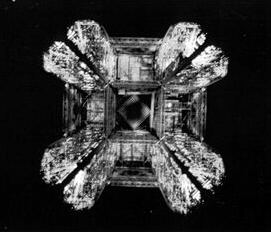
| The Universality of the Symmetry Concept |
|---|
Magdolna Hargittai, Structural Chemist
Budapest Technical University, Budapest, Hungary
 The
notion of symmetry brings together beauty and usefulness, science
and economy, mathematics and human relations. This presentation
demonstrates the breadth and versatility of the symmetry concept.
There are no symmetries specific to various disciplines, yet
there are differences in emphasis in applications of the concept.
The sciences, humanities and arts have gradually drifted apart;
symmetry can provide a connecting link among them. The symmetry
concept may be broadened to include harmony and proportion, constituents
of symmetry often present in architectural composition.
The
notion of symmetry brings together beauty and usefulness, science
and economy, mathematics and human relations. This presentation
demonstrates the breadth and versatility of the symmetry concept.
There are no symmetries specific to various disciplines, yet
there are differences in emphasis in applications of the concept.
The sciences, humanities and arts have gradually drifted apart;
symmetry can provide a connecting link among them. The symmetry
concept may be broadened to include harmony and proportion, constituents
of symmetry often present in architectural composition.
Point group symmetries includebilateral symmetry, present when two halves of the whole are each other's mirror images, and rotational symmetry, present when an object, rotating around its axis, appears two or more times during a full revolution. Commonly, reflection and rotation appear together. Viewing the Eiffel tower from below we find twice two orthogonal reflection planes which generate a four-fold rotation. Regular polygons have both rotational and reflectional symmetry. Buckminster Fuller's geodesic dome inspired chemists to visualize the structure of a newly discovered substance as a truncated icosahedron.
A special kind of point-group symmetry is chiral symmetry, present when two objects, related by mirror reflection, cannot be superposed. In Christopher Wren's design for the Royal Hospital at Greenwich, the placement of eccentric towers on otherwise symmetrical rectangular buildings forms two chiral objects.
Space-group symmetries are created by simple repetition of a basic motif, and describe the most economical growth and expansion patterns. Border decorations are examples of one-dimensional space-group symmetry in which a pattern can be generated through translational symmetry by repeating a motif at equal intervals. Repetition can be achieved by a shift in direction, or it may be done by reflection, rotation or glide-reflection. Helices and spirals display one-dimensional space-group symmetries although, as a spiral staircase, they may extend to three dimensions.
While mathematical symmetry is exact and rigorous, the symmetry we encounter in everyday life is much more relaxed. The broad interpretation of the symmetry concept, coming close to blending fact and fantasy, may help scientists recognize trends, changes, and patterns.
|
István Hargittai and Magdolna Hargittai, "The Universality of the Symmetry Concept", pp. 81-95 in Nexus: Architecture and Mathematics, ed. Kim Williams, Fucecchio (Florence): Edizioni dell'Erba, 1996. http://www.nexusjournal.com/conferences/N1996-Hargittai.html |
|
|
|
|
